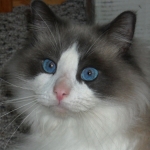Symptoms: Excessive Daytime Sleepiness, Sleepiness Scale of 12, frequent awakenings out of sleep and positive snoring.
Total recording time: 459 minutes
Total sleep time: 411 minutes
Sleep Efficiency: 89%
Latency to sleep: 21 minutes
Latency to REM sleep: 220 minutes
Stage 1: 4 minutes, 1% of total sleep time
Stage 2: 301 minutes, 72% of total sleep time
Stage 3 and 4: 64 minutes, 15% of total sleep time
Stage REM: 42 minutes, 10% of total sleep time
Wake after sleep onset: 26 minutes
AHI: 27 per hour
REM AHI: 16 per hour (all of REM is in the right sided position)
NonREM AHI: 29 per hour
Baseline oxygen saturation: 93-95%
Minimum oxygen saturation: 81% during nonREM sleep in the supine position
Number of events: Central Apneas 4, Obstructive Apneas 8, Mixed Apneas 0, Hypopneas 179
Arousal Summary: Arousal index is highly elevated at 29 per hour
HR between 68-90 beats per minute during sleep
Periodic Limb Movements of sleep are absent
*****************************************************************************************
Titration Study: Recommended pressure 10cm
Best setting tested during REM sleep was 9cm with occasional respiratory events leading to an AHI of 8 per hour and some discernible flow limitation. Pressure was increased to 10cm with was tested during nonREM sleep only and 11cm only applied for the last approximately 6 minutes of recording time. During Stage II sleep there was no particular difference between 10 and 11 cm. All sleep was in supine posture. Minimal oxygen saturation on CPAP 9cm during REM sleep appears to be 92%.
Number of Events: Central Apneas 5, Obstructive Apneas 24, Mixed Apneas 5, Hypopneas 15.
Arousal Summary: Arousal index is 17 per hour
EMG: Periodic limb movements of sleep are noted as very brief clusters while on pressure of 8 and higher; these average out to a rate of 6 per hour. PLM arousal index is calculated at 0. There is normal chin EMG atonia during REM sleep.
*******************************************************************************************
I'm still learning what all this means, so feel free to comment and explain if you wish. I understand that this is not meant to be a substitution to physician interpretation, blah disclaimer, blah disclaimer, I will not sue you.
Sleep Study Results
- SleepyHound
- Posts: 36
- Joined: Fri May 06, 2011 9:15 pm
- Location: Midwest US
Sleep Study Results
_________________
| Machine: ResMed AirSense™ 10 AutoSet™ CPAP Machine with HumidAir™ Heated Humidifier |
| Mask: AirFit™ P10 For Her Nasal Pillow CPAP Mask with Headgear |
| Additional Comments: AHI 30.7 |
If chocolate could sing, it would sound like Josh Groban.
- SleepyHound
- Posts: 36
- Joined: Fri May 06, 2011 9:15 pm
- Location: Midwest US
Re: Sleep Study Results
I read Snoredog's post somewhere about the definitions and relevance of all the data. Thanks, Snoredog!
_________________
| Machine: ResMed AirSense™ 10 AutoSet™ CPAP Machine with HumidAir™ Heated Humidifier |
| Mask: AirFit™ P10 For Her Nasal Pillow CPAP Mask with Headgear |
| Additional Comments: AHI 30.7 |
If chocolate could sing, it would sound like Josh Groban.
Re: Sleep Study Results
Snoredog's left us a few years ago... he's dead.
Re: Sleep Study Results
In a nutshell, you have moderate OSAHS with the majority of your events being hypopneas (apnea wanna be's). Recommended pressure is 10 so if you get yourself an auto cpap you probably want to have it set at 8-12 to start off with. Using software to monitor your therapy will help you tweak your settings to optimize your therapy.
Your task now will be to educate yourself on the types of machines available... You want a fully data capable auto-titrating cpap machine. Fully data capable means full efficacy data not just compliance data. The top three-selling machines are the ResMed S9 Autoset, PR System One Auto w/A-Flex, and the DeVilbiss Intellipap AutoAdjust. Each of these has a variety of features, software that is readily available, and excellent ratings.
You should determine your selection to whether or not you are using insurance or buying outright. Insurance may use select DME's and therefore limit your machine choice on what brands they carry. You'll need to do your homework. 95% of your therapy success will be getting the right mask.... some of us luck out right away, and others will go through a dozen masks before finding just the right one.
Best of luck to you..... keep reading and asking questions. Find Janknitz's posts and click her blog link in her signature to read important info for newbies dealing with DME's.
Your task now will be to educate yourself on the types of machines available... You want a fully data capable auto-titrating cpap machine. Fully data capable means full efficacy data not just compliance data. The top three-selling machines are the ResMed S9 Autoset, PR System One Auto w/A-Flex, and the DeVilbiss Intellipap AutoAdjust. Each of these has a variety of features, software that is readily available, and excellent ratings.
You should determine your selection to whether or not you are using insurance or buying outright. Insurance may use select DME's and therefore limit your machine choice on what brands they carry. You'll need to do your homework. 95% of your therapy success will be getting the right mask.... some of us luck out right away, and others will go through a dozen masks before finding just the right one.
Best of luck to you..... keep reading and asking questions. Find Janknitz's posts and click her blog link in her signature to read important info for newbies dealing with DME's.
Yes, that blue eyed beauty is my cat! He is a seal point, bi-color Ragdoll. I adopted him in '08 from folks who could no longer care for him. He is a joy and makes me smile each and every day.









